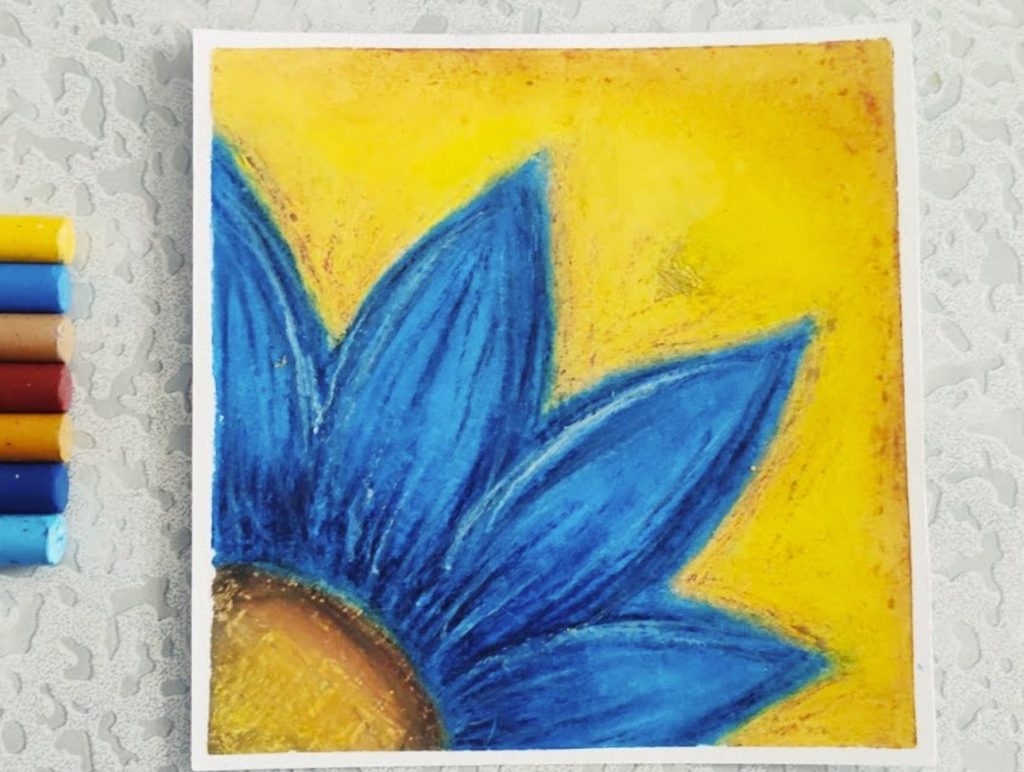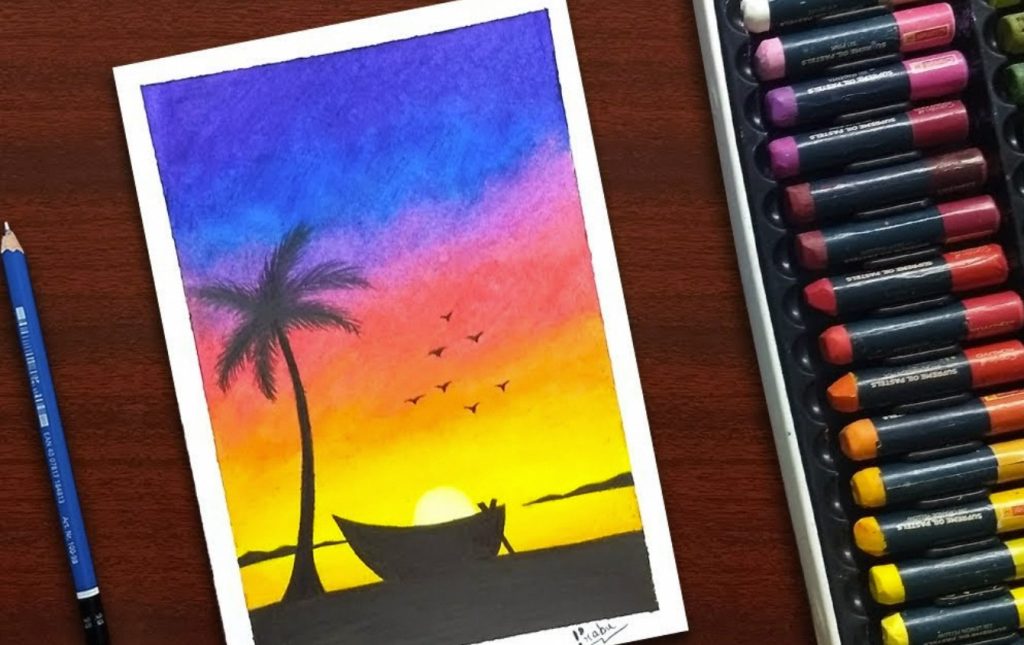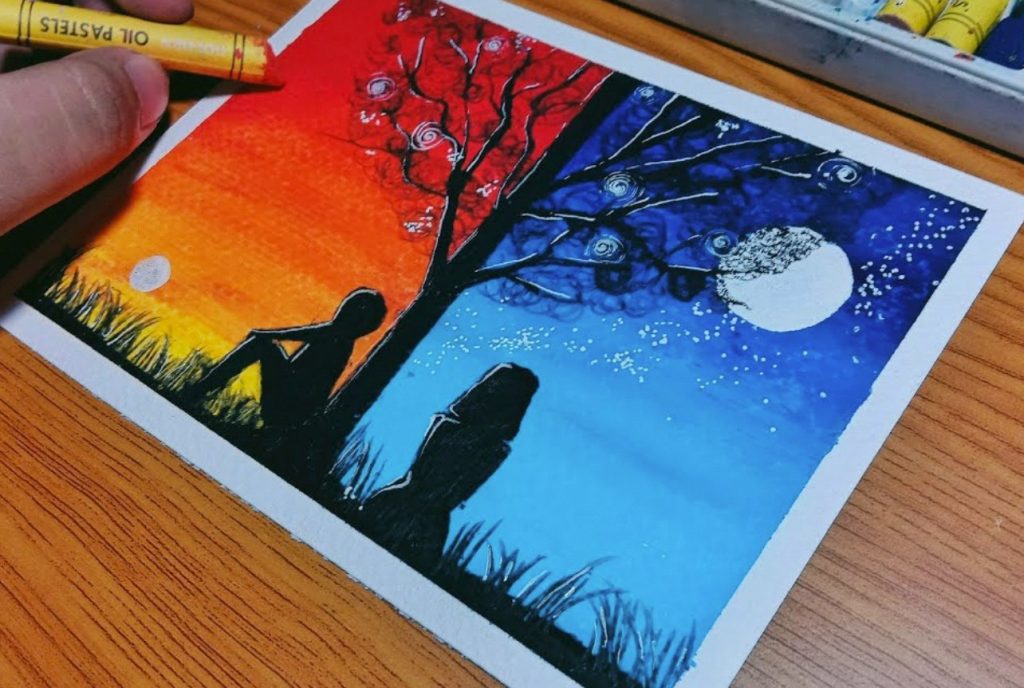Oil pastels, with their vibrant colors and smooth textures, are a perfect tool for igniting young imaginations and fostering artistic exploration. Unlike traditional pastels that require a lighter touch, oil pastels blend beautifully and create rich textures, making them ideal for mess-free and expressive artwork for children. This guide explores a collection of simple oil pastel drawing ideas, designed to engage young minds and nurture a lifelong love for art.

Part 1: A World of Colors
1. Rainbow Fish Frenzy:
Let’s dive into a colorful underwater adventure! Begin by having your child draw a simple oval shape on their paper to represent the body of a fish. Encourage them to use vibrant colors like blue, yellow, and orange to fill it in. Experiment with layering different colors to create a shimmering effect for a truly magical fish. Don’t forget the details! Help your child add a playful eye with a black or white pastel and a curved fin using contrasting colors. Multiple fishes of different sizes and colors swimming across the paper creates a delightful underwater scene, allowing them to explore a wide range of colors in a fun and thematic way.
2. Pattern Playtime:
Creating colorful patterns is a fun and engaging way for kids to explore the versatility of oil pastels. Provide them with a sheet of paper and let them choose a base color to fill the background. Encourage them to experiment with drawing simple shapes like squares, circles, and triangles in different colors across the paper. Let them draw repeating patterns like stripes, polka dots, or zigzags, or even create their own unique designs. This activity allows for creativity and exploration without limitations, fostering a sense of accomplishment with each completed design.

Part 2: Textural Adventures
1. Scratchy Surprise Animals:
Oil pastels offer exciting textural possibilities. Begin with your child drawing a simple animal shape like a cat or a dog on their paper using a light color. Next, let them apply a darker color on top, completely covering the first layer. Now comes the magic! Using a toothpick (with adult supervision), help them gently scratch away sections of the top layer, revealing the lighter color underneath. This technique can create interesting fur textures, adding depth and dimension to their artwork. They can even create grass for the animal to stand on using green pastels and a scratching technique for a textured effect.
2. Blotting and Blending Landscapes:
Exploring texture doesn’t have to be limited to scratching. Help your child create a simple landscape scene with a textured sky. Start by having them apply a light blue base color to the top half of their paper. Now crumple up a piece of tissue paper and dab it into a darker blue pastel. Encourage them to gently press the crumpled tissue paper onto the light blue background, creating a textured and blended sky effect. For the ground, they can use a light brown pastel and a blending stump to create smooth transitions, adding a few simple shapes like trees or houses to complete the scene. This activity allows them to explore blending techniques while creating a captivating landscape artwork.
Part 3: Let’s Draw Something Fun!

1. Happy Fruits and Silly Faces:
Let’s embark on a delightful artistic adventure by creating a still life masterpiece! Offer your child paper and oil pastels, and encourage them to draw simple shapes like circles to represent apples and pears. Guide them to experiment with vibrant colors such as red, yellow, and orange to fill in the fruits, while adding details such as stems and leaves using green pastels. It’s important to infuse the fruits with personality by adding expressive eyes and wide smiles, creating a cheerful and whimsical still life composition. This delightful activity not only allows children to explore basic shapes and colors but also fosters creativity and imagination. It’s a fun way for them to develop their artistic skills while enjoying the process of creating their own colorful and lively still life artwork.
2. My Magical Castle Adventure:
Let’s build a magical castle! Start by having your child draw a large rectangle for the castle base on their paper. Encourage them to add smaller rectangles on top for towers and a pointed triangle for the roof. Let them use vibrant colors to bring their castle to life, adding details like windows and doors with contrasting colors. Don’t forget the magic! Encourage them to draw swirls and patterns around the castle with different colors, representing magical spells or a fantastical environment. This activity allows for exploring basic shapes and building structures while encouraging imaginative storytelling through their artwork.

Part 4: Keep the Fun Going!
1. Combine Techniques for Creativity
Oil pastels offer versatile possibilities and allow for combining various techniques to create unique and captivating effects in artworks. Encourage your child to experiment with layering colors to add depth and dimension to their creations. They can also explore the use of blending tools to achieve smooth transitions between different hues, creating a seamless and vibrant look. Additionally, incorporating the scratching technique into their artwork can add texture and visual interest. For example, they could try drawing simple shapes on top of their background and then use the scratching technique to reveal the colors underneath, resulting in a layered and visually dynamic effect. It’s important to remind them that the more they experiment and explore different techniques, the more they will uncover the boundless creative potential of oil pastels. This process not only enhances their artistic skills but also encourages them to develop their unique style and artistic voice.
2. Inspiration Everywhere:
Open your child’s eyes to the world around them! Take walks in nature, visit art galleries or museums, and observe the vibrant colors and textures they encounter. Encourage them to take photos or make simple sketches to capture these inspirations and translate them into their next oil pastel creations. Learning to appreciate the beauty in everyday objects and nature will fuel their artistic journey for years to come.

By incorporating these simple oil pastel drawing ideas, you can provide a springboard for endless creative exploration for your child. Remember, there are no mistakes in art! Celebrate their imagination, embrace experimentation, and watch their artistic confidence blossom with every vibrant masterpiece they create.


